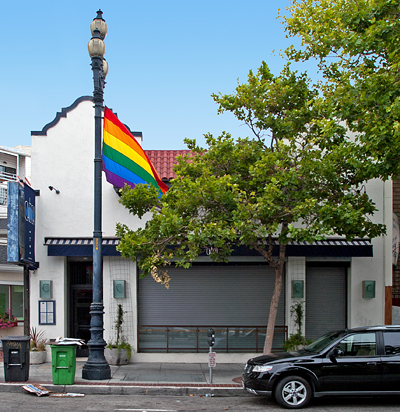San Francisco Landmarks
Jose Theater / NAMES Project
2362 Market Street
Built 1913
NAMES Project 1986-2001
The Jose Theatre operated here from 1913 to 1919.
The NAMES Project was located here from 1986 to 2001.
Catch, a seafood restaurant, is now [March 2012] here.

This building was the place of origin for the NAMES Project and associated AIDS Quilt, an internationally significant project created as a political organizing tool and an expression of worldwide grief over the AIDS epidemic.
In 1986, gay community activist Cleve Jones created the first panel of what was to become the Quilt in memory of his friend Marvin Feldman. In June 1987, he and a small group gathered at 2362 Market Street, a small San Francisco storefront near Castro Street and the center of the gay community, to formally organize The NAMES Project. Their goal was to create a memorial for those who had died of AIDS and in doing so help people understand the devastating impact of the disease.
Public response to The AIDS Memorial Quilt was immediate. People in each of the U.S. cities most affected by AIDS at that time - New York, Los Angles, Atlanta, Philadelphia and San Francisco - sent panels to the Market Street Workshop in memory of friends and loved ones.
The Quilt numbered 40 panels when it first appeared at the June 1987 San Francisco Lesbian and Gay Freedom Day Parade.
The Quilt's first national display on October 11, 1987 spread 1,920 panels across the National Mall in Washington, literally blanketing an area the size of two football fields. Half a million people visited The Quilt that weekend.
Before the first display of the Quilt in Washington in 1987, the open, warehouse-like space at 2362 Market Street, where the project had begun, seemed cavernous. Even after that display, there were only 160 12xl2's folded into small bundles on shelves along one wall. The room rapidly filled up with areas allotted for sewing machines, merchandise storage and shipping, a 12 by 12 foot area to layout the 12x12's for assembly and work areas in the narrow mezzanine for the first seven staff members.
2362 Market Street became an impromptu community center for this gay neighborhood that had been so severely impacted by the AIDS epidemic. It was a place to talk about the people who were gone, to grieve publicly with friends and, sadly, to find out that someone you knew had, in fact, died. Yet, in addition to people from the neighborhood, people from all over the United States and the world found their way to 2362 Market Street to deliver a panel made by friends back home or to come together to meet, perhaps for the first time, to make a panel for a cherished friend, child or partner.
One of the often told stories is of a woman who took a bus from her home in West virginia to deliver a panel she made, in secret, for her son. When asked why she had not just sent the panel, she replied that she didn't think that the place was real and she couldn't just put her son in an envelope and mail him away. She had to witness the place where the memory of her son would reside.
In less than two years, the NAMES Project leased space in an adjoining building for staff offices leaving the Quilt more space to be stored, maintained, assembled and viewed in the now crowded room at 2362 Market. After seven years at 2362 Market Street, in 1993, the Quilt finally outgrew its quarters. By that time there were nearly 30,000 panels, over 2,500 12x12's.
The NAMES Project and most of the Quilt moved to larger space in the South of Market neighborhood at 310 Brannan Street. The 2362 Market Street space was transformed into a visitors and volunteer center and a place for the sewing to continue for those who came there from all over the country to seek the comfort of the Quilt. The staff of the NAMES Project responded to requests for viewing individual panels and would bring them here for loved ones to view the panels privately.
The NAMES Project Visitor's Center remained at 2362 Market Street until 2001 when the NAMES Project and the AIDS Memorial Quilt moved to Atlanta where space was provided by the Centers for Disease control.
An estimated 1.2 million people visited The Quilt when it was shown in its entirety in Washington, D.C. in October 1996. Covering the national Mall from the Washington Monument to the grounds of the U.S. Capitol Building, The Quilt occupied an area equal to 24 football fields and weighed more than 50 tons. Some 2,500 new panels were added to The Quilt over the three days it was on display, putting the total number of panels at more than 40,000. Over 10,000 volunteers came to Washington from around the world to make the display happen and for the first time, a U.S. President and Vice President visited a display of the entire AIDS Memorial Quilt.
In September 1996, Simon and Schuster released the book Always Remember, a retrospective of panels created by and for a spectrum of international fashion designers.
Currently [2004], The AIDS Memorial Quilt weighs over 56 tons, was created by over 100,000 people and is comprised of over 48,000 panels, 5.600 12x12's, dedicated to more than 88,000 individuals. It is the premier international symbol of the AIDS pandemic and the largest piece of community folk art in the world - a living memorial to a generation lost to AIDS. As such, each panel of The Quilt is a repository of American culture and an artistic documentary of the individual memorialized, the surviving panel maker, and the moment in time in which it was created.
Source: Planning Commission Resolution No. 16710 dated 15 January 2004.
